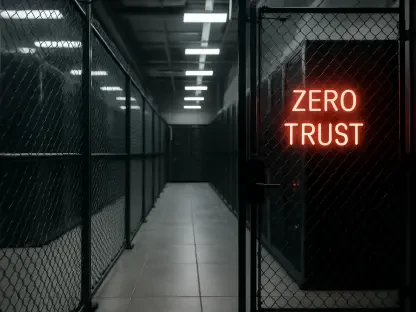In the rapidly evolving landscape of Internet of Things (IoT) and electronics manufacturing, the protection of intellectual property (IP) stands as a paramount concern for companies striving to maintain a competitive edge. The financial toll of IP theft is staggering, with annual losses in the US estimated between $225 billion and $600 billion, in the UK at roughly $11.7 billion, and across the European Union at approximately $65 billion. These numbers paint a stark picture of a global crisis that undermines innovation and profitability. As manufacturers increasingly rely on outsourced production to cut costs and scale operations, they inadvertently expose their proprietary designs and data to significant risks. From overproduction by contract manufacturers to sophisticated cyberattacks, the vulnerabilities in the supply chain are numerous and growing. This pressing issue demands not only awareness but also actionable strategies to secure the very foundation of technological advancement in an interconnected world.
Unpacking the Challenges in IoT Supply Chains
The Perils of Outsourced Manufacturing
The allure of outsourcing production to third-party manufacturers lies in its cost-effectiveness and scalability, yet it introduces a host of vulnerabilities that can jeopardize a company’s IP. When firms, ranging from emerging startups to established players like Dyson, hand over control of their designs and firmware to external partners, they risk unauthorized overproduction. This practice, where manufacturers produce more units than agreed upon, often floods markets with excess products, directly cutting into legitimate sales and profit margins. Beyond this, the lack of direct oversight means sensitive data can slip through cracks, whether through negligence or intentional misuse. The economic impact of such breaches is profound, as companies lose not only revenue but also the trust of their stakeholders. Addressing this issue requires a fundamental shift in how manufacturers approach partnerships, prioritizing security and control over mere cost savings in an era where IP is as valuable as physical assets.
Another dimension of this challenge is the inherent difficulty in monitoring global supply chains, where multiple parties and regions are involved. The complexity of these networks often obscures visibility, making it nearly impossible to detect discrepancies or unauthorized activities until significant damage has already occurred. For instance, a manufacturer in one country might subcontract portions of production to another, further diluting accountability. This fragmented structure amplifies the risk of IP leakage, as each handoff increases the chance of data exposure. Moreover, cultural and legal differences across borders can complicate enforcement of IP rights, leaving companies vulnerable to exploitation. Tackling this multifaceted problem demands not only robust agreements but also innovative tools to track and manage production processes, ensuring that every step in the supply chain aligns with the company’s security protocols and expectations.
The Rising Threat of Cyberattacks and Insider Risks
Cyberattacks have emerged as a formidable threat to IoT supply chains, with hackers increasingly targeting sensitive design files, firmware, and production systems. The sophistication of these attacks has grown, exploiting vulnerabilities in interconnected systems to steal proprietary information or disrupt operations. High-profile incidents, such as the 2023 ASML breach involving stolen semiconductor data, demonstrate the devastating potential of such threats. These attacks often result in massive financial losses and long-term damage to brand reputation. As supply chains become more digitized, the attack surface expands, making it imperative for manufacturers to invest in cutting-edge cybersecurity measures. Protecting IP in this environment is not just about safeguarding data but also about preserving the integrity of entire production ecosystems against relentless digital adversaries.
Insider threats, whether stemming from malice or accidental lapses, add another layer of risk to the already complex landscape of supply chain security. Employees or trusted partners with access to critical IP can become conduits for breaches, as seen in various real-world cases where sensitive information was leaked or sold. The 2025 Nucor Corporation breach serves as a stark reminder of how even well-intentioned insiders can inadvertently compromise security through phishing schemes or poor data handling practices. Such incidents underscore the need for stringent access controls and continuous monitoring within organizations and their extended networks. Training programs to educate staff on security protocols, combined with robust systems to detect unusual activity, are essential to mitigate these risks. As the lines between internal and external threats blur, a comprehensive approach to insider risk management becomes a critical component of IP protection.
Building Robust Defenses for IoT IP
Implementing Advanced Technical Solutions
To counter the myriad risks facing IoT manufacturers, technical safeguards provide a critical first line of defense in protecting IP. Embedding secure hardware elements, such as dedicated security chips, into circuit boards can effectively lock down firmware, making it nearly impossible for unauthorized parties to clone or tamper with designs. Additionally, encrypting software during production ensures that even if data is intercepted, it remains unreadable without the proper keys. Techniques like assigning unique identifiers to each unit enable traceability, allowing companies to monitor production and detect anomalies such as overproduction in real time. Remote certificate management through secure servers further minimizes exposure by ensuring that sensitive digital credentials, vital for IoT device communication, are never shared with third-party manufacturers. These layered technical measures create a formidable barrier against IP theft in an increasingly hostile digital landscape.
Beyond hardware and encryption, real-time analytics play a pivotal role in maintaining supply chain integrity. By analyzing production data as it is generated, manufacturers can quickly identify deviations from agreed-upon volumes or schedules, flagging potential overproduction or unauthorized access. Limiting production batches, such as restricting orders to 500 boards at a time, adds another layer of control, reducing the window of opportunity for misuse. These proactive approaches not only deter potential breaches but also provide actionable insights for refining security protocols. The integration of such technologies reflects a broader shift toward data-driven decision-making in manufacturing, where every piece of information becomes a tool for safeguarding innovation. As threats evolve, staying ahead requires continuous investment in cutting-edge solutions that adapt to new risks while maintaining operational efficiency across global supply chains.
Strengthening Legal and Operational Frameworks
Technical defenses alone are not sufficient; contractual and operational protections form an equally vital pillar in securing IP within IoT supply chains. Well-crafted agreements with manufacturers should include specific clauses that define IP ownership, limit production runs to prevent overproduction, and grant audit rights to ensure compliance. These legal tools provide a framework for accountability, enabling companies to take swift action if terms are violated. Additionally, operational strategies such as periodic audits of manufacturing facilities help verify adherence to agreements, uncovering discrepancies before they escalate into major breaches. By combining legal safeguards with hands-on oversight, manufacturers can create a robust system that deters misuse and reinforces trust with partners, ensuring that IP remains protected even in complex, multi-tiered supply chains.
Another critical aspect of operational protection lies in fostering a culture of vigilance and collaboration across all levels of the supply chain. Establishing clear communication channels with manufacturing partners ensures that expectations around IP security are understood and prioritized. Regular reviews of contractual terms, adapted to reflect emerging risks or regulatory changes, keep agreements relevant and enforceable. Furthermore, investing in third-party audits or independent assessments can provide an unbiased perspective on a manufacturer’s compliance with security standards. This multi-pronged approach not only mitigates immediate risks but also builds long-term resilience against evolving threats. As the stakes of IP theft continue to rise, integrating legal precision with operational diligence offers a balanced strategy for protecting innovation in a competitive global market.
Navigating the Evolving Regulatory Landscape
Compliance with tightening regulatory standards is no longer a choice but a necessity for IoT manufacturers aiming to protect their IP. The EU’s Cyber Resilience Act, set to enforce rigorous security requirements by late 2027 with penalties reaching up to 2.5% of global turnover for non-compliance, exemplifies the global push for accountability. Similarly, updates to the UK’s Intellectual Property Act underscore the importance of aligning with legal frameworks to avoid costly sanctions. These regulations demand greater transparency and control over supply chains, pushing companies to integrate security into every stage of production. Staying abreast of such mandates not only mitigates legal risks but also positions firms as leaders in secure innovation, turning compliance into a competitive differentiator in a crowded marketplace.
Equally important is the proactive adaptation to emerging regulatory trends, such as the EU’s proposed Design Directive recast from 2024, which addresses digital threats like 3D printing and virtual IP theft. Manufacturers must anticipate these changes by embedding compliance considerations into their strategic planning, ensuring that their processes and products meet future standards. This forward-thinking approach requires close collaboration with legal experts and industry bodies to interpret and implement evolving requirements effectively. By doing so, companies can avoid the pitfalls of non-compliance while enhancing their reputation for reliability and security. As the regulatory landscape continues to shift, viewing these obligations as opportunities rather than burdens can drive innovation, encouraging the development of safer, more trustworthy IoT solutions that resonate with consumers and regulators alike.
Reflecting on a Path Forward
Looking back, the journey to secure IP in IoT manufacturing revealed a landscape fraught with challenges, from the economic devastation of theft to the intricate vulnerabilities of outsourced production. Billions were lost annually to breaches and counterfeiting, while cyberattacks and insider threats exposed critical weaknesses in global supply chains. The unique complexities of IoT devices, reliant on digital certificates, compounded these risks, as did the tightening grip of regulations like the EU Cyber Resilience Act. Yet, through this struggle, actionable solutions emerged—technical innovations like secure hardware and encryption, fortified by strong contracts and compliance efforts, proved their worth. Moving forward, manufacturers must prioritize integrated strategies that evolve with threats, invest in real-time monitoring to catch issues early, and view regulatory alignment as a gateway to trust and market leadership. Only by embracing these steps can the industry hope to protect its innovations and sustain growth in an ever-connected world.









